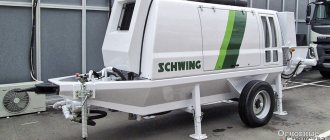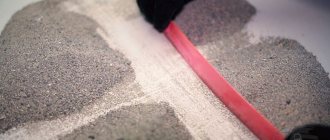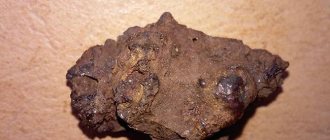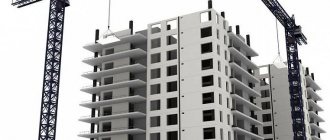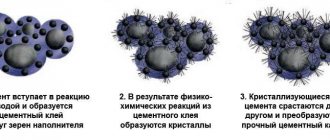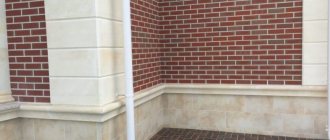To ensure reliable and uninterrupted supply of mortar at a construction site, a concrete pipeline is used for a concrete pump. Modern construction sites involve the use of many devices to facilitate work. With their help, you can increase the pace of construction and significantly reduce the construction time of a particular object. Let's figure out what they are, what they consist of and how they work.
What is a concrete pipeline
A concrete pipeline is a special pipeline used to pump a concrete mixture from point A to point B. Structurally, the device includes several elements, including: links, seals, valves, pipes, locks, concrete pipeline hoses and other parts that ensure the operation of the entire system. These parts are connected to the concrete pump - the “heart” of the concrete pipeline.
Depending on the required length of the line, fastening of the concrete pipeline can be ensured by connecting it to the boom of pumping equipment at the construction site or in the building. The equipment pipes themselves are made of corrosion-resistant materials and are highly reliable, durable and wear-resistant.
Design features
The concrete pipeline is assembled from all-metal corrosion-resistant pipes, which are connected using special lever locks. On straight sections of the pipeline, straight pipe links are used; knee bends are used to create bends. The concrete pipe is connected to the output flange of the concrete pump using a connecting pipe.
The concrete pipeline is equipped with a needle valve designed to stop pumping concrete in case of need or unexpected breakdown. In addition, for these purposes, in order to quickly disconnect the concrete pipes, a quick-release link is built into it. This link reduces labor costs when carrying out repairs or washing and cleaning the device.
The purpose of the concrete pipeline
The main task of a concrete pipeline for a concrete pump is to supply mortar to a remote distance from the pumping equipment. With the help of a modern stationary concrete pipeline or similar equipment of another class, you can decently:
- reduce energy costs;
- reduce labor resources;
- speed up construction processes.
Moreover, the concrete mixture, which is used when pumping from one point to another, can be either prepared directly at the construction site or brought in a concrete truck. After all, the supply of the substance will still be carried out by concrete pipes connected to pneumatic equipment. Once the mixture reaches the final point, it can be used for its main purpose - the construction of reinforced concrete monolithic buildings.
Design features of a typical concrete pipeline
In the simplest solution, this is a steel pipe of a certain diameter with a corrosion-resistant internal coating, complemented by connecting lever locks, rotary inserts, a needle-type valve, a rotary distribution chute and other components and installation parts.
The system includes:
- check valve to block the supply of solution in the event of an emergency;
- quick-release connection for preventive cleaning of the internal pipe diameter.
Connected to the outlet discharge pipe of a mobile or stationary concrete pump, the pipeline delivers and dispenses the solution to all areas, including high-altitude areas of the facility being built. The main line is assembled from pipe sections with a wall thickness of 4-6 mm and a length of 2 to 4 meters.
The length of the concrete pipeline is determined by the rated capacity of the pump and the lifting height. The technology allows for a significant increase in the solution supply distance due to extension sections. Experts recommend the use of flexible hoses of identical diameter, reinforced with reinforcement, ranging in length from one to seven meters.
What does a concrete pipeline for a concrete pump consist of?
Structurally, a concrete pipeline usually includes the following 5 elements:
- Concrete pipes. The material of concrete pipeline pipes is steel or special metal, which is additionally reinforced with rubber (seamless pipes). Such pipes ensure the most reliable and stable operation of all equipment. The standard length of 1 section of a concrete pipeline is 1–3 meters, and pipes with rubber reinforcement are 4 meters. Of course, the market offers concrete pipes of other lengths, but most often such solutions are made to order.
- Hoses. The design also uses concrete pipeline hoses, which are installed at the ends of the highways where it is necessary to collect or supply concrete mixture.
- Concrete pipe elbow. The knee element serves to ensure rotation of the pipeline and change the angle of the concrete pipeline. If you do not ensure smooth flow of the mixture through the concrete pipe, congestion may occur in the system pipes. The result is interruptions in the operation of equipment and the loss of a certain amount of working concrete.
- Lock - clamp (concrete pipe flange). The quality of the flange when installing a concrete pipeline determines the strength characteristics of all equipment, the safety of work on a construction site, as well as the prompt execution of all construction work where it is necessary to use a concrete mixture.
- Sponge flushing ball for concrete pipe or cylinder. These elements are used to flush the concrete pipeline after completion of work. With their help, you can eliminate the remaining solution and dirt inside the pipes. Cylinders or sponge balls are designed for a specific concrete pipe diameter (usually 12.5 cm)
- Other parts: valves for shutting off the supply of the mixture, concrete pipeline seals, distribution stations, compactors and other auxiliary elements, which may differ depending on the specific concrete pipeline and the method of its organization.
Regarding the last point. The needle-type stop valve, which is installed in front of the bend - the corner of the concrete pipeline, deserves special attention here. With its help, you can urgently stop the operation of the equipment drive (pump). Such a valve is equipped with a quickly replaceable element for prompt disassembly of concrete pipeline pipes (if the situation requires it). It is this element that allows you to reduce labor and resource costs, and also speeds up repairs if faults are detected in the concrete pipes.
Cleaning the system
Fragments of solution hardened in the pipe reduce pumping performance, and ultimately can damage all the component equipment. The service technology involves periodic flushing of the internal section of the pipeline with running water supplied under pressure.
- The first flush kit consists of a water pressure and transfer valve and a hose. This equipment must be kept in good working order and stored in a specially designated place next to the concrete pump.
- The second set includes several sponge-polymer wads identical to the internal cross-section of the concrete pipeline. Pre-moistened balls are placed at the beginning of the pipeline through a quick-release coupling. Under excess water pressure, the wad moves along the pipe, removing traces of concrete mortar from the inner walls.
Timely washing of concrete pipes ensures uninterrupted operation of the system and complete exhaustion of the assigned operational resource.
It is especially important to know that a two- or three-hour delay in final cleaning of the system can result in forced downtime. Significant, additional costs of working time cannot be excluded for partial dismantling of the emergency fragment of the pipeline and removal of hardened fragments of the solution by other, low-productivity methods.
As a result, a high-quality set of concrete pipeline pipes, with proper operation and full service maintenance, fully pays for its own cost in an average of two years. Moreover, the system can be operated trouble-free for several more intensive and productive construction seasons.
Using a concrete pipeline and the intricacies of its work
Of course, the first step is to install the concrete pipeline. This process is worth considering in more detail.
Pipeline installation
The installation of a stationary concrete pipeline is carried out taking into account the individual characteristics of a particular construction site. Therefore, the parameters of the concrete pipeline pipes will also be personalized for a specific construction project. What specific parameters are usually taken into account when installing a concrete pipeline:
- taking into account the type of topography of the construction site (important when choosing the type of specific system - for example, a flexible concrete pipeline consisting of hoses or a concrete pipeline with metal pipes);
- the ability to maximize the straightness of concrete pipelines for concrete pumps (relevant when organizing the supply of concrete in any ground conditions, since it is with straightness that it will be possible to carry out repairs and maintenance of equipment as quickly and easily as possible);
- calculation of angles, since the installation of a concrete pipeline involves placing pipes not only in a horizontal, but also a vertical plane and determining the need to use distribution booms (devices connected to the place where concrete is poured).
In addition, when installing a concrete pipeline, you need to pay maximum attention to the strength of all connecting elements, as well as systematically check the reliability of the installed supports. Another important parameter that needs to be controlled when installing concrete pipes is the maximum turning radius (it may differ depending on the parameters of the pipes).
Subtleties of equipment operation
Above, we have already looked at how concrete pipes for concrete pumps work - in simple words, they simply pump the construction mixture from one point to another. But you need to remember about the subtleties of the operation of this equipment - it is as follows:
- The piston mechanism pumps the concrete mixture. Since the machine operates on the basis of hydraulics, the mixture is supplied as smoothly as possible, without jerks or jumps.
- If a rotary concrete pipeline is used, a different principle is used here - the concrete does not go through the injection stage, but immediately enters the pipeline. Such a system is equipped with special rollers located outside the concrete pipe; they help the mixture to push inside the concrete pipe and get to the receiving point of the working mixture.
The speed at which the solution will flow through the concrete pipes depends on the length of the structure, as well as the power of the concrete pump that delivers the mixture.
System cleaning
The concrete pipeline is cleaned and washed after completion of work. This must be done, since the concrete mixture remaining inside the pipes, when set, can make them unsuitable for further use. The concrete pipe is cleaned and washed with warm water. To carry out this procedure you need:
- compressor;
- pipeline for supplying compressed air and water;
- sufficient supply of water;
- metal balls and cylinders made of sponge material with a diameter corresponding to the diameter of the pipes used.
A compressor uses compressed air or water to push balls or cylinders through the pipes, thus removing the remaining solution from the inner surface of the concrete pipes. This allows you to keep them in working condition throughout their entire service life.
Features of installing a concrete pipeline system
A mobile concrete pipeline is suspended from a crane boom or other lifting and transport device, while a stationary one is laid in any convenient and safe place on the construction site.
When assembling a concrete pipeline, it is recommended to use flat areas of the terrain and maintain the straightness of its design. The presence of elbows and bends can make it difficult to clean the internal section of the pipe and its final flushing.
Horizontal sections of the concrete pipeline are installed on strong supports located at intervals of 2.5-3 meters. When laying on a soil base, it is recommended to use leveling wooden spacers.
When assembling the system, special attention should be paid to the strength of the pipe connections and the reliability of the concrete pipeline supports. You should also determine the maximum turning radius.
As a result
Important! Before proceeding with the installation of a concrete pipeline, calculations are made, on the basis of which the number of pipes, elbows, locks and other parts is determined. What this system looks like can be seen in the photos posted on the Internet.
Laying a concrete pipeline creates maximum convenience for supplying ready-made solutions to the pouring site. From the reviews you can find out how effective and practical such a system is and what you should pay attention to when using it. Read the pros and cons of strip foundations in this article.
Main components of the system
Concrete pipeline installation.
The concrete pipeline consists of solid steel pipes made of corrosion-resistant metal. Lever locks connect pipes. If the pipeline laying section is straight, straight links are used, if there are bends, knee links are used. Using a connecting pipe, the beginning of the concrete transportation system is mounted to the concrete pump through its outlet flange.
A needle valve is attached to the concrete pipeline. It stops the solution if the installation is stopped. The valve is installed before the pipeline bend. The concrete pipeline has a quick-release section for disconnecting the pipeline if necessary. The presence of this section significantly reduces labor costs and repair time. The concrete pipeline also has specialized cleaning devices.
Return to contents


